 W
WBioretention is the process in which contaminants and sedimentation are removed from stormwater runoff. Stormwater is collected into the treatment area which consists of a grass buffer strip, sand bed, ponding area, organic layer or mulch layer, planting soil, and plants. Runoff passes first over or through a sand bed, which slows the runoff's velocity, distributes it evenly along the length of the ponding area, which consists of a surface organic layer and/or groundcover and the underlying planting soil. The ponding area is graded, its center depressed. Water is ponded to a depth of 15 cm (5.9 in) and gradually infiltrates the bioretention area or is evapotranspired. The bioretention area is graded to divert excess runoff away from itself. Stored water in the bioretention area planting soil exfiltrates over a period of days into the underlying soils.
 W
WBioswales are channels designed to concentrate and convey stormwater runoff while removing debris and pollution. Bioswales can also be beneficial in recharging groundwater.
 W
WA constructed wetland (CW) is an artificial wetland to treat municipal or industrial wastewater, greywater or stormwater runoff. It may also be designed for land reclamation after mining, or as a mitigation step for natural areas lost to land development.
 W
WA detention basin or retarding basin is an excavated area installed on, or adjacent to, tributaries of rivers, streams, lakes or bays to protect against flooding and, in some cases, downstream erosion by storing water for a limited period of time. These basins are also called "dry ponds", "holding ponds" or "dry detention basins" if no permanent pool of water exists. Detention ponds that are designed to permanently retain some volume of water at all times are called retention basins. In its basic form, a detention basin is used to manage water quantity while having a limited effectiveness in protecting water quality, unless it includes a permanent pool feature.
 W
WA Drainage Spout, downspout, waterspout, downpipe, drain spout, roof drain pipe, leader is a pipe for carrying rainwater from a rain gutter.
 W
WA storm drain, storm sewer, surface water drain/sewer, or stormwater drain is infrastructure designed to drain excess rain and ground water from impervious surfaces such as paved streets, car parks, parking lots, footpaths, sidewalks, and roofs. Storm drains vary in design from small residential dry wells to large municipal systems.
 W
WA detention basin or retarding basin is an excavated area installed on, or adjacent to, tributaries of rivers, streams, lakes or bays to protect against flooding and, in some cases, downstream erosion by storing water for a limited period of time. These basins are also called "dry ponds", "holding ponds" or "dry detention basins" if no permanent pool of water exists. Detention ponds that are designed to permanently retain some volume of water at all times are called retention basins. In its basic form, a detention basin is used to manage water quantity while having a limited effectiveness in protecting water quality, unless it includes a permanent pool feature.
 W
WA dry well or drywell is an underground structure that disposes of unwanted water, most commonly surface runoff and stormwater and in some cases greywater. It is a covered, porous-walled chamber that allows water to slowly soak into the ground, dissipating into the groundwater. Such structures are often called a soakaway in the United Kingdom, a soakwell in Australia, and a soak pit in India.
 W
WThe Deposito de Evaporación Solar "El Caracol" is a large spiral-shaped retention basin located over the former lakebed of Lake Texcoco, northeast of Mexico City, in the municipio of Ecatepec de Morelos, Mexico.
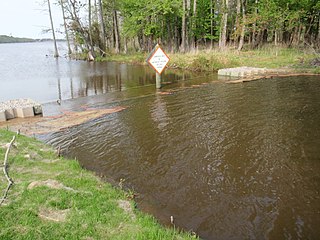 W
WA flow control structure is a device that alters the flow of water in a stream, drainage channel or pipe. As a group these are passive structures since they operate without intervention under different amounts of water flow and their impact changes based on the quantity of water available. This includes weirs, flow splitters and proprietary-design devices that are used for stormwater management and in combined sewers.
 W
WA French drain or weeping tile is a trench filled with gravel or rock or containing a perforated pipe that redirects surface water and groundwater away from an area.
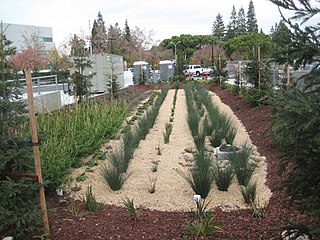 W
WGreen infrastructure is defined in the United States by section 502 of the Clean Water Act as the range of measures that use plant or soil systems, permeable surfaces, stormwater harvest and reuse, infiltrate or evapotranspirate stormwater and reduce flows to sewer systems or to surface waters. Green infrastructure encompasses various water management practices such as vegetated rooftops, absorbent gardens and other measures to capture, filter, and reduce stormwater. Green infrastructure prevents or reduces the amount of water that flows into storm drains and is proved as an important tool for cities with combined sewer overflows and nutrient problems. It provides many environmental, social, and economic benefits such as improved surface water quality, water conservation, and community safety. Green Infrastructure is a cost effective and resilient approach to managing stormwater. While gray stormwater infrastructure is designed to move stormwater away from the built environment, green infrastructure treats the water at the source.
 W
WHydrodynamic separators (HDS) are stormwater management devices that use cyclonic separation to control water pollution. They are designed as flow-through structures with a settling or separation unit to remove sediment and other pollutants. HDS are considered structural best management practices (BMPs), and are used to treat and pre-treat stormwater runoff.
 W
WAn infiltration basin, is a type of device that is used to manage stormwater runoff, prevent flooding and downstream erosion, and improve water quality in an adjacent river, stream, lake or bay. It is essentially a shallow artificial pond that is designed to infiltrate stormwater through permeable soils into the groundwater aquifer. Infiltration basins do not release water except by infiltration, evaporation or emergency overflow during flood conditions.
 W
WA media filter is a type of filter that uses a bed of sand, peat, shredded tires, foam, crushed glass, geo-textile fabric, anthracite, crushed granite or other material to filter water for drinking, swimming pools, aquaculture, irrigation, stormwater management, oil & gas operations, and other applications.
 W
WMonier Ventilation Shaft 1 is a heritage-listed ventilation shaft at 500 Wickham Terrace, Spring Hill, City of Brisbane, Queensland, Australia. It was designed by Joseph Monier and built c. 1904. It was added to the Queensland Heritage Register on 4 August 1998.
 W
WMonier Ventilation Shaft 2 is a heritage-listed ventilation shaft at 134 St Paul's Terrace, Spring Hill, City of Brisbane, Queensland, Australia. It was designed by Joseph Monier and built c. 1904. It was added to the Queensland Heritage Register on 4 August 1998.
 W
WMonier Ventilation Shaft 3 is a heritage-listed ventilation shaft at Florence Street, Teneriffe, City of Brisbane, Queensland, Australia. It was designed by Joseph Monier and built c. 1904. It was added to the Queensland Heritage Register on 4 August 1998.
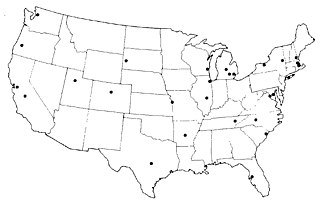 W
WThe Nationwide Urban Runoff Program (NURP) is a research project conducted by the United States Environmental Protection Agency (EPA) between 1979 and 1983. It was the first comprehensive study of urban stormwater pollution across the United States.
 W
WUrban runoff is surface runoff of rainwater created by urbanization. This runoff is a major source of flooding and water pollution in urban communities worldwide.
 W
WOptiRTC is an American technology company that has developed a software as a service platform for civil infrastructure. The OptiRTC platform is a cloud-native platform that integrates sensors, forecasts, and environmental contexts to actively control stormwater infrastructure. The OptiRTC platform is built on Microsoft Azure and uses internet of things technology to predicatively manage distributed water systems.
 W
WA percolation trench, also called an infiltration trench, is a type of best management practice (BMP) that is used to manage stormwater runoff, prevent flooding and downstream erosion, and improve water quality in an adjacent river, stream, lake or bay. It is a shallow excavated trench filled with gravel or crushed stone that is designed to infiltrate stormwater though permeable soils into the groundwater aquifer.
 W
WRain gardens, also called bioretention facilities, are one of a variety of practices designed to treat polluted stormwater runoff. Rain gardens are designed landscape sites that reduce the flow rate, total quantity, and pollutant load of runoff from impervious urban areas like roofs, driveways, walkways,and parking lots, and compacted lawn areas. Rain gardens rely on plants and natural or engineered soil medium to retain stormwater and increase the lag time of infiltration, while remediating and filtering pollutants carried by urban runoff. Rain gardens provide a method to reuse and optimize any rain that falls, reducing or avoiding the need for additional irrigation. A benefit of planting rain gardens is the consequential decrease in ambient air and water temperature, a mitigation that is especially effective in urban areas containing an abundance of impervious surfaces that absorb heat in a phenomenon known as the heat-island effect.
 W
WA rain gutter, eavestrough, eaves-shoot or surface water collection channel is a component of a water discharge system for a building. It is necessary to prevent water dripping or flowing off roofs in an uncontrolled manner for several reasons: to prevent it damaging the walls, drenching persons standing below or entering the building, and to direct the water to a suitable disposal site where it will not damage the foundations of the building. In the case of a flat roof, removal of water is essential to prevent water ingress and to prevent a build-up of excessive weight.
 W
WA retention basin, sometimes called a wet pond, wet detention basin or stormwater management pond (SWMP), is an artificial pond with vegetation around the perimeter, and includes a permanent pool of water in its design. It is used to manage stormwater runoff to prevent flooding and downstream erosion, and improve water quality in an adjacent river, stream, lake or bay.
 W
WA sediment basin is a temporary pond built on a construction site to capture eroded or disturbed soil that is washed off during rain storms, and protect the water quality of a nearby stream, river, lake, or bay. The sediment-laden soil settles in the pond before the runoff is discharged. Sediment basins are typically used on construction sites of 5 acres (20,000 m2) or more, where there is sufficient room. They are often used in conjunction with erosion controls and other sediment control practices. On smaller construction sites, where a basin is not practical, sediment traps may be used.
 W
WA sediment control is a practice or device designed to keep eroded soil on a construction site, so that it does not wash off and cause water pollution to a nearby stream, river, lake, or sea. Sediment controls are usually employed together with erosion controls, which are designed to prevent or minimize erosion and thus reduce the need for sediment controls. Sediment controls are generally designed to be temporary measures, however, some can be used for storm water management purposes.
 W
WSherbourne Common, designed by landscape architect Phillips Farevaag Smallenberg, is a waterfront park located in a former industrial area of Toronto. It is one of the earliest parks in Canada to incorporate a neighborhood-wide storm water treatment facility into its design. Located east of Lower Sherbourne Street, the 1.47 hectare park spans two city blocks. It stretches from Lake Ontario to Lake Shore Boulevard in the north.
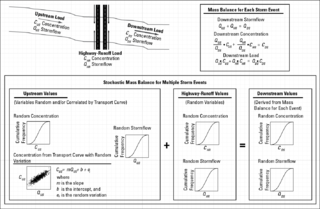 W
WThe stochastic empirical loading and dilution model (SELDM) is a stormwater quality model. SELDM is designed to transform complex scientific data into meaningful information about the risk of adverse effects of runoff on receiving waters, the potential need for mitigation measures, and the potential effectiveness of such management measures for reducing these risks. The U.S. Geological Survey developed SELDM in cooperation with the Federal Highway Administration to help develop planning-level estimates of event mean concentrations, flows, and loads in stormwater from a site of interest and from an upstream basin. SELDM uses information about a highway site, the associated receiving-water basin, precipitation events, stormflow, water quality, and the performance of mitigation measures to produce a stochastic population of runoff-quality variables. Although SELDM is, nominally, a highway runoff model is can be used to estimate flows concentrations and loads of runoff-quality constituents from other land use areas as well. SELDM was developed by the U.S. Geological Survey so the model, source code, and all related documentation are provided free of any copyright restrictions according to U.S. copyright laws and the USGS Software User Rights Notice. SELDM is widely used to assess the potential effect of runoff from highways, bridges, and developed areas on receiving-water quality with and without the use of mitigation measures.. Stormwater practitioners evaluating highway runoff commonly use data from the Highway Runoff Database (HRDB) with SELDM to assess the risks for adverse effects of runoff on receiving waters.
 W
WStormwater, also spelled storm water, is water that originates from rain, including snow and ice melt. Stormwater can soak into the soil (infiltrate), be stored on the land surface in ponds and puddles, evaporate, or contribute to surface runoff. Most runoff is conveyed directly to nearby streams, rivers, or other water bodies without treatment.
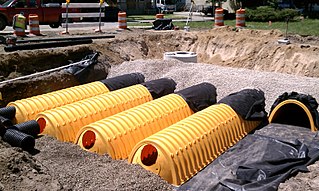 W
WA stormwater detention vault is an underground structure designed to manage excess stormwater runoff on a developed site, often in an urban setting. This type of best management practice may be selected when there is insufficient space on the site to infiltrate the runoff or build a surface facility such as a detention basin or retention basin.
 W
WStormwater harvesting or stormwater reuse is the collection, accumulation, treatment or purification, and storage of stormwater for its eventual reuse. While rainwater harvesting collects precipitation primarily from rooftops, stormwater harvesting deals with collection of runoff from creeks, gullies, ephemeral streams, and other ground conveyances. It can also include catchment areas from developed surfaces, such as roads or parking lots, or other urban environments such as parks, gardens and playing fields.
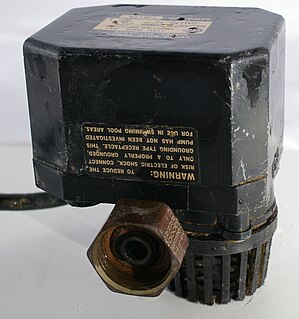 W
WA sump pump is a pump used to remove water that has accumulated in a water-collecting sump basin, commonly found in the basements of homes. The water may enter via the perimeter drains of a basement waterproofing system, funneling into the basin or because of rain or natural ground water, if the basement is below the water table level.
 W
WA tree box filter is a best management practice (BMP) or stormwater treatment system widely implemented along sidewalks, street curbs, and car parks. They are used to control the volume and amount of urban runoff pollutants entering into local waters, by providing areas where water can collect and naturally infiltrate or seep into the ground. Such systems usually consist of a tree planted in a soil media, contained in a small, square, concrete box. Tree box filters are popular bioretention and infiltration practices, as they collect, retain, and filter runoff as it passes through vegetation and microorganisms in the soil. The water is then either consumed by the tree or transferred into the storm drain system.
 W
WUrban runoff is surface runoff of rainwater created by urbanization. This runoff is a major source of flooding and water pollution in urban communities worldwide.
 W
WVillage Homes is a planned community in Davis, Yolo County, California. It is designed to be ecologically sustainable by harnessing the energies and natural resources that exist in the landscape, especially stormwater and solar energy.
 W
WWater-sensitive urban design (WSUD) is a land planning and engineering design approach which integrates the urban water cycle, including stormwater, groundwater and wastewater management and water supply, into urban design to minimise environmental degradation and improve aesthetic and recreational appeal. WSUD is a term used in the Middle East and Australia and is similar to low-impact development (LID), a term used in the United States; and Sustainable Drainage System (SuDS), a term used in the United Kingdom.
 W
WA retention basin, sometimes called a wet pond, wet detention basin or stormwater management pond (SWMP), is an artificial pond with vegetation around the perimeter, and includes a permanent pool of water in its design. It is used to manage stormwater runoff to prevent flooding and downstream erosion, and improve water quality in an adjacent river, stream, lake or bay.